A Multi-Criteria Analysis Approach to Identify Flood Risk Asset Damage Hotspots in Western Australia
Abstract
1. Introduction
- This is the first paper that aims to design a heterogeneous and integrated data island for asset management that provides a holistic and coherent view of the current scattered data sources;
- This study aims to implement an effective MCA model, which indicates hotspots that embody a high probability of asset damage due to runoff;
- The practical impact of this study is to provide relevant governmental agencies with a data-driven asset management system, so that agencies can launch timely and effective responses to extreme climate conditions and their impacts.
2. Literature Review
2.1. Water Resources Models
2.2. Flood Prediction Models
2.3. Digital Elevation Model
2.4. Multi-Criteria Analysis
2.5. Current and Future Sustainable Environment
3. Methodology
3.1. Data Acquisition, Assimilation, and Integration
3.2. Pressure on Assets
3.3. Develop Risk Hotspots through a Probabilistic Approach
3.4. Validation of Hotspot
4. Results and Discussion
4.1. Data Acquisition
4.2. Pressure on Assets
4.3. Multi-Criteria Analysis
4.4. Hazard Vulnerability
5. Discussion and Limitations
6. Conclusions
Author Contributions
Funding
Institutional Review Board Statement
Informed Consent Statement
Data Availability Statement
Conflicts of Interest
References
- Liu, J.; Zhang, Y.; Yang, Y.; Gu, X.; Xiao, M. Investigating relationships between Australian flooding and large-scale climate indices and possible mechanism. J. Geophys. Res. Atmos. 2018, 123, 8708–8723. [Google Scholar] [CrossRef]
- Berland, A.; Shiflett, S.A.; Shuster, W.D.; Garmestani, A.S.; Goddard, H.C.; Herrmann, D.L.; Hopton, M.E. The role of trees in urban stormwater management. Landsc. Urban Plan. 2017, 162, 167–177. [Google Scholar] [CrossRef] [PubMed]
- Khayan, K.; Husodo, A.H.; Astuti, I.; Sudarmadji, S.; Djohan, T.S. Rainwater as a source of drinking water: Health impacts and rainwater treatment. J. Environ. Public Health 2019, 2019, 1760950. [Google Scholar] [CrossRef] [PubMed]
- Newhart, K.B.; Holloway, R.W.; Hering, A.S.; Cath, T.Y. Data-driven performance analyses of wastewater treatment plants: A review. Water Res. 2019, 157, 498–513. [Google Scholar] [CrossRef] [PubMed]
- Matheswaran, K.; Alahacoon, N.; Pandey, R.; Amarnath, G. Flood risk assessment in South Asia to prioritize flood index insurance applications in Bihar, India. Geomat. Nat. Hazards Risk 2019, 10, 26–48. [Google Scholar] [CrossRef]
- Pallathadka, A.; Sauer, J.; Chang, H.; Grimm, N.B. Urban flood risk and green infrastructure: Who is exposed to risk and who benefits from investment? A case study of three US Cities. Landsc. Urban Plan. 2022, 223, 104417. [Google Scholar] [CrossRef]
- Molinari, D.; De Bruijn, K.M.; Castillo-Rodríguez, J.T.; Aronica, G.T.; Bouwer, L.M. Validation of flood risk models: Current practice and possible improvements. Int. J. Disaster Risk Reduct. 2019, 33, 441–448. [Google Scholar] [CrossRef]
- Scaini, A.; Stritih, A.; Brouillet, C.; Scaini, C. Flood risk and river conservation: Mapping citizen perception to support sustainable river management. Front. Earth Sci. 2021, 9, 510. [Google Scholar] [CrossRef]
- Abu-Salih, B.; Wongthongtham, P.; Zhu, D.; Chan, K.Y.; Rudra, A.; Abu-Salih, B.; Wongthongtham, P.; Zhu, D.; Chan, K.Y.; Rudra, A. Predictive analytics using Social Big Data and machine learning. In Social Big Data Analytics: Practices, Techniques, and Applications; Springer: Singapore, 2021; pp. 113–143. [Google Scholar]
- Hawchar, L.; Naughton, O.; Nolan, P.; Stewart, M.G.; Ryan, P.C. A GIS-based framework for high-level climate change risk assessment of critical infrastructure. Clim. Risk Manag. 2020, 29, 100235. [Google Scholar] [CrossRef]
- Kumar, N.; Poonia, V.; Gupta, B.B.; Goyal, M.K. A novel framework for risk assessment and resilience of critical infrastructure towards climate change. Technol. Forecast. Soc. Chang. 2021, 165, 120532. [Google Scholar] [CrossRef]
- Pathak, S.; Liu, M.; Jato-Espino, D.; Zevenbergen, C. Social, economic and environmental assessment of urban sub-catchment flood risks using a multi-criteria approach: A case study in Mumbai City, India. J. Hydrol. 2020, 591, 125216. [Google Scholar] [CrossRef]
- Brimfield, B.E.; Myers, S.D. An integrated approach to benefits realisation of railway condition monitoring innovations. In Proceedings of the 5th IET Conference on Railway Condition Monitoring and Non-Destructive Testing (RCM 2011), Derby, UK, 29–30 November 2011. [Google Scholar]
- Li, Q.; Kumar, A. National & International Practices in Decision Support Tools in Road Asset Management; CRC for Construction Innovation: Brisbane, QLD, Australia, 2003. [Google Scholar]
- Christodoulou, S.; Deligianni, A. A neurofuzzy decision framework for the management of water distribution networks. Water Resour. Manag. 2010, 24, 139–156. [Google Scholar] [CrossRef]
- Sobieraj, J.; Bryx, M.; Metelski, D. Stormwater Management in the City of Warsaw: A Review and Evaluation of Technical Solutions and Strategies to Improve the Capacity of the Combined Sewer System. Water 2022, 14, 2109. [Google Scholar] [CrossRef]
- Hafeez, F.; Frost, A.; Vaze, J.; Dutta, D.; Smith, A.; Elmahdi, A. A new integrated continental hydrological simulation system. Water J. Aust. Water Assoc. 2015, 42, 75–82. [Google Scholar]
- Viney, N.; Vaze, J.; Crosbie, R.; Wang, B.; Dawes, W.; Frost, A. AWRA-L v5.0: Technical Description of Model Algorithms and Inputs; CSIRO: Perth, SA, Australia, 2015. [Google Scholar] [CrossRef]
- Elmahdi, A.; Hafeez, M.; Smith, A.; Frost, A.; Vaze, J.; Dutta, D. Australian Water Resources Assessment Modelling System (AWRAMS)-informing water resources assessment and national water accounting. In Proceedings of the 36th Hydrology and Water Resources Symposium: The Art and Science of Water, Hobart, TAS, Australia, 7–10 December 2015; Engineers Australia: Barton, CBR, Australia, 2015; p. 979. [Google Scholar]
- Frost, A.J.; Ramchurn, A.; Hafeez, M. Evaluation of the Bureau’s Operational AWRA-L Model; Bureau of Meteorology: Melbourne, VIC, Australia, 2016; p. 80.
- Raupach, M.R.; Briggs, P.R.; Haverd, V.; King, E.A.; Paget, M.; Trudinger, C.M. Australian Water Availability Project (AWAP): CSIRO Marine and Atmospheric Research Component: Final Report for Phase 3; Centre for Australian Weather and Climate Research (Bureau of Meteorology and CSIRO): Melbourne, VIC, Australia, 2009; p. 67.
- Wang, Y.P.; Kowalczyk, E.; Leuning, R.; Abramowitz, G.; Raupach, M.R.; Pak, B.; van Gorsel, E.; Luhar, A. Diagnosing errors in a land surface model (CABLE) in the time and frequency domains. J. Geophys. Res. Biogeosci. 2011, 116, G01034. [Google Scholar] [CrossRef]
- Kowalczyk, E.A.; Wang, Y.P.; Law, R.M.; Davies, H.L.; McGregor, J.L.; Abramowitz, G. The CSIRO Atmosphere Biosphere Land Exchange (CABLE) model for use in climate models and as an offline model. CSIRO Mar. Atmos. Res. Pap. 2006, 13, 42. [Google Scholar]
- Mosavi, A.; Ozturk, P.; Chau, K.-W. Flood prediction using machine learning models: Literature review. Water 2018, 10, 1536. [Google Scholar] [CrossRef]
- Van den Honert, R.C.; McAneney, J. The 2011 Brisbane floods: Causes, impacts and implications. Water 2011, 3, 1149–1173. [Google Scholar] [CrossRef]
- Shrestha, D.L.; Robertson, D.E.; Wang, Q.J.; Pagano, T.C.; Hapuarachchi, H.A. Evaluation of numerical weather prediction model precipitation forecasts for short-term streamflow forecasting purpose. Hydrol. Earth Syst. Sci. 2013, 17, 1913–1931. [Google Scholar] [CrossRef]
- Daley, R. Atmospheric Data Analysis; Cambridge University Press: Cambridge, UK, 1993. [Google Scholar]
- Echeverribar, I.; Morales-Hernández, M.; Brufau, P.; García-Navarro, P. 2D numerical simulation of unsteady flows for large scale floods prediction in real time. Adv. Water Resour. 2019, 134, 103444. [Google Scholar] [CrossRef]
- Yoon, S.-S. Adaptive blending method of radar-based and numerical weather prediction QPFs for urban flood forecasting. Remote Sens. 2019, 11, 642. [Google Scholar] [CrossRef]
- Kundzewicz, Z.W.; Pińskwar, I.; Brakenridge, G.R. Changes in river flood hazard in Europe: A review. Hydrol. Res. 2018, 49, 294–302. [Google Scholar] [CrossRef]
- Shakirah, J.A.; Sidek, L.M.; Hidayah, B.; Nazirul, M.Z.; Jajarmizadeh, M.; Ros, F.C.; Roseli, Z.A. A review on flood events for kelantan river watershed in malaysia for last decade (2001–2010). IOP Conf. Ser. Earth Environ. Sci. 2016, 32, 012070. [Google Scholar] [CrossRef]
- Kenley, R.; Harfield, T.; Bedggood, J. Road asset management: The role of location in mitigating extreme flood maintenance. Procedia Econ. Financ. 2014, 18, 198–205. [Google Scholar] [CrossRef]
- Kim, B.; Sanders, B.F.; Han, K.; Kim, Y.; Famiglietti, J.S. Calibration of stormwater management model using flood extent data. In Proceedings of the Institution of Civil Engineers-Water Management; Thomas Telford Ltd.: London, UK, 2014; pp. 17–29. [Google Scholar]
- Beecroft, A.; Peters, E.; Toole, T. Life-cycle costing of rain and flood events in Queensland—Case studies and network-wide implications. Road Transp. Res. J. Aust. New Zealand Res. Pract. 2017, 26, 22–35. [Google Scholar]
- Costabile, P.; Costanzo, C.; Macchione, F. Comparative analysis of overland flow models using finite volume schemes. J. Hydroinform. 2012, 14, 122–135. [Google Scholar] [CrossRef]
- Lee, T.H.; Georgakakos, K.P. Operational Rainfall Prediction on Meso-γ Scales for Hydrologic Applications. Water Resour. Res. 1996, 32, 987–1003. [Google Scholar] [CrossRef]
- Hu, Z.-J.; Wang, L.-L.; Tang, H.-W.; Qi, X.-M. Prediction of the future flood severity in plain river network region based on numerical model: A case study. J. Hydrodyn. Ser. B 2017, 29, 586–595. [Google Scholar] [CrossRef]
- Costabile, P.; Costanzo, C.; Macchione, F. A storm event watershed model for surface runoff based on 2D fully dynamic wave equations. Hydrol. Process. 2013, 27, 554–569. [Google Scholar] [CrossRef]
- Valipour, M.; Banihabib, M.E.; Behbahani, S.M.R. Comparison of the ARMA, ARIMA, and the autoregressive artificial neural network models in forecasting the monthly inflow of Dez dam reservoir. J. Hydrol. 2013, 476, 433–441. [Google Scholar] [CrossRef]
- Elsafi, S.H. Artificial neural networks (ANNs) for flood forecasting at Dongola Station in the River Nile, Sudan. Alex. Eng. J. 2014, 53, 655–662. [Google Scholar] [CrossRef]
- Deo, R.C.; Şahin, M. Application of the artificial neural network model for prediction of monthly standardized precipitation and evapotranspiration index using hydrometeorological parameters and climate indices in eastern Australia. Atmos. Res. 2015, 161, 65–81. [Google Scholar] [CrossRef]
- Ramana, R.V.; Krishna, B.; Kumar, S.R.; Pandey, N.G. Monthly rainfall prediction using wavelet neural network analysis. Water Resour. Manag. 2013, 27, 3697–3711. [Google Scholar] [CrossRef]
- Shamim, M.A.; Hassan, M.; Ahmad, S.; Zeeshan, M. A comparison of artificial neural networks (ANN) and local linear regression (LLR) techniques for predicting monthly reservoir levels. KSCE J. Civ. Eng. 2016, 20, 971–977. [Google Scholar] [CrossRef]
- Araghinejad, S.; Azmi, M.; Kholghi, M. Application of artificial neural network ensembles in probabilistic hydrological forecasting. J. Hydrol. 2011, 407, 94–104. [Google Scholar] [CrossRef]
- Cunningham, S.C.; Griffioen, P.; White, M.D.; Nally, R.M. Assessment of ecosystems: A system for rigorous and rapid mapping of floodplain forest condition for Australia’s most important river. Land Degrad. Dev. 2018, 29, 127–137. [Google Scholar] [CrossRef]
- Prasad, R.; Deo, R.C.; Li, Y.; Maraseni, T. Input selection and performance optimization of ANN-based streamflow forecasts in the drought-prone Murray Darling Basin region using IIS and MODWT algorithm. Atmos. Res. 2017, 197, 42–63. [Google Scholar] [CrossRef]
- Cannas, B.; Fanni, A.; Sias, G.; Tronci, S.; Zedda, M.K. River flow forecasting using neural networks and wavelet analysis. Geophys. Res. Abstr 2005, 7, 08651. [Google Scholar]
- Tantanee, S.; Patamatammakul, S.; Oki, T.; Sriboonlue, V.; Prempree, T. Coupled wavelet-autoregressive model for annual rainfall prediction. J. Environ. Hydrol. 2005, 13, 1–8. [Google Scholar]
- Mekanik, F.; Imteaz, M.A.; Talei, A. Seasonal rainfall forecasting by adaptive network-based fuzzy inference system (ANFIS) using large scale climate signals. Clim. Dyn. 2016, 46, 3097–3111. [Google Scholar] [CrossRef]
- Kisi, O.; Nia, A.M.; Gosheh, M.G.; Tajabadi, M.R.J.; Ahmadi, A. Intermittent streamflow forecasting by using several data driven techniques. Water Resour. Manag. 2012, 26, 457–474. [Google Scholar] [CrossRef]
- Li, C.; Guo, S.; Zhang, J.; Guo, J. A modified NLPM-ANN model and its application to flood forecasting. Eng. J. Wuhan Univ. 2009, 42, 1–5. [Google Scholar]
- Huang, S.; Chang, J.; Huang, Q.; Chen, Y. Monthly streamflow prediction using modified EMD-based support vector machine. J. Hydrol. 2014, 511, 764–775. [Google Scholar] [CrossRef]
- Bass, B.; Bedient, P. Surrogate modeling of joint flood risk across coastal watersheds. J. Hydrol. 2018, 558, 159–173. [Google Scholar] [CrossRef]
- Tan, Q.-F.; Lei, X.-H.; Wang, X.; Wang, H.; Wen, X.; Ji, Y.; Kang, A.-Q. An adaptive middle and long-term runoff forecast model using EEMD-ANN hybrid approach. J. Hydrol. 2018, 567, 767–780. [Google Scholar] [CrossRef]
- Ravansalar, M.; Rajaee, T.; Kisi, O. Wavelet-linear genetic programming: A new approach for modeling monthly streamflow. J. Hydrol. 2017, 549, 461–475. [Google Scholar] [CrossRef]
- Shafapour Tehrany, M.; Shabani, F.; Jebur, M.N.; Hong, H.; Chen, W.; Xie, X. GIS-based spatial prediction of flood prone areas using standalone frequency ratio, logistic regression, weight of evidence and their ensemble techniques. Geomat. Nat. Hazards Risk 2017, 8, 1538–1561. [Google Scholar] [CrossRef]
- Manfreda, S.; Nardi, F.; Samela, C.; Grimaldi, S.; Taramasso, A.C.; Roth, G.; Sole, A. Investigation on the use of geomorphic approaches for the delineation of flood prone areas. J. Hydrol. 2014, 517, 863–876. [Google Scholar] [CrossRef]
- Papaioannou, G.; Vasiliades, L.; Loukas, A. Multi-criteria analysis framework for potential flood prone areas mapping. Water Resour. Manag. 2015, 29, 399–418. [Google Scholar] [CrossRef]
- Majumder, R.; Bhunia, G.S.; Patra, P.; Mandal, A.C.; Ghosh, D.; Shit, P.K. Assessment of flood hotspot at a village level using GIS-based spatial statistical techniques. Arab. J. Geosci. 2019, 12, 409. [Google Scholar] [CrossRef]
- Aksoy, H.; Kirca, V.S.O.; Burgan, H.I.; Kellecioglu, D. Hydrological and hydraulic models for determination of flood-prone and flood inundation areas. Proc. Int. Assoc. Hydrol. Sci. 2016, 373, 137–141. [Google Scholar] [CrossRef]
- Falguni, M.; Singh, D. Detecting flood prone areas in Harris County: A GIS based analysis. GeoJournal 2020, 85, 647–663. [Google Scholar]
- Pratidina, G.; Santoso, P.B. Detection of satellite data-based flood-prone areas using logistic regression in the central part of Java Island. J. Phys. Conf. Ser. 2019, 1367, 012086. [Google Scholar] [CrossRef]
- Mishra, K.; Sinha, R. Flood risk assessment in the Kosi megafan using multi-criteria decision analysis: A hydro-geomorphic approach. Geomorphology 2020, 350, 106861. [Google Scholar] [CrossRef]
- Rana, V.K.; Suryanarayana, T.M.V. GIS-based multi criteria decision making method to identify potential runoff storage zones within watershed. Ann. GIS 2020, 26, 149–168. [Google Scholar] [CrossRef]
- Rozos, D.; Bathrellos, G.D.; Skillodimou, H.D. Comparison of the implementation of rock engineering system and analytic hierarchy process methods, upon landslide susceptibility mapping, using GIS: A case study from the Eastern Achaia County of Peloponnesus, Greece. Environ. Earth Sci. 2011, 63, 49–63. [Google Scholar] [CrossRef]
- Stefanidis, S.; Stathis, D. Assessment of flood hazard based on natural and anthropogenic factors using analytic hierarchy process (AHP). Nat. Hazards 2013, 68, 569–585. [Google Scholar] [CrossRef]
- Saaty, T.L. A scaling method for priorities in hierarchical structures. J. Math. Psychol. 1977, 15, 234–281. [Google Scholar] [CrossRef]
- Cegan, J.C.; Filion, A.M.; Keisler, J.M.; Linkov, I. Trends and applications of multi-criteria decision analysis in environmental sciences: Literature review. Environ. Syst. Decis. 2017, 37, 123–133. [Google Scholar] [CrossRef]
- Ellis, J.B.; Deutsch, J.-C.; Mouchel, J.-M.; Scholes, L.; Revitt, M.D. Multicriteria decision approaches to support sustainable drainage options for the treatment of highway and urban runoff. Sci. Total Environ. 2004, 334, 251–260. [Google Scholar] [CrossRef]
- Ouma, Y.O.; Yabann, C.; Kirichu, M.; Tateishi, R. Optimization of urban highway bypass horizontal alignment: A methodological overview of intelligent spatial MCDA approach using fuzzy AHP and GIS. Adv. Civ. Eng. 2014, 2014, 182568. [Google Scholar] [CrossRef]
- Zhao, X.-X.; Zheng, M.; Fu, Q. How natural disasters affect energy innovation? The perspective of environmental sustainability. Energy Econ. 2022, 109, 105992. [Google Scholar] [CrossRef]
- Lu, L.-C.; Chiu, S.-Y.; Chiu, Y.-H.; Chang, T.-H. Sustainability efficiency of climate change and global disasters based on greenhouse gas emissions from the parallel production sectors—A modified dynamic parallel three-stage network DEA model. J. Environ. Manag. 2022, 317, 115401. [Google Scholar] [CrossRef] [PubMed]
- Zhang, K.; Chen, G.; Xia, Y.; Wang, S. An Ensemble-Based, Remote-Sensing-Driven, Flood-Landslide Early Warning System. In Remote Sensing of Water-Related Hazards; John Wiley & Sons: Hoboken, NJ, USA, 2022; pp. 123–134. [Google Scholar]
- Rais, A.M.; Nur, A.N.P.; Tricahyaningati, D. Android Real Time Earthquake & Tsunami Warning Alert System Based on Open Data of Indonesia Government Agency of Geophysics. IOP Conf. Ser. Earth Environ. Sci. 2022, 1095, 012008. [Google Scholar]
- Sufi, F.K.; Khalil, I. Automated disaster monitoring from social media posts using AI-based location intelligence and sentiment analysis. IEEE Trans. Comput. Soc. Syst. 2022; early access. [Google Scholar] [CrossRef]
- Kuller, M.; Bach, P.M.; Ramirez-Lovering, D.; Deletic, A. Framing water sensitive urban design as part of the urban form: A critical review of tools for best planning practice. Environ. Model. Softw. 2017, 96, 265–282. [Google Scholar] [CrossRef]
- Radcliffe, J.C. History of water sensitive urban design/low impact development adoption in Australia and internationally. In Approaches to Water Sensitive Urban Design; Elsevier: Amsterdam, The Netherlands, 2019. [Google Scholar]
- Yuan, Z.; Liang, C.; Li, D. Urban stormwater management based on an analysis of climate change: A case study of the Hebei and Guangdong provinces. Landsc. Urban Plan. 2018, 177, 217–226. [Google Scholar] [CrossRef]
- Adugna, D.; Lemma, B.; Jensen, M.B.; Gebrie, G.S. Evaluating the hydraulic capacity of existing drain systems and the management challenges of stormwater in Addis Ababa, Ethiopia. J. Hydrol. Reg. Stud. 2019, 25, 100626. [Google Scholar] [CrossRef]
- Pham, B.T.; Luu, C.; Van Phong, T.; Nguyen, H.D.; Van Le, H.; Tran, T.Q.; Ta, H.T.; Prakash, I. Flood risk assessment using hybrid artificial intelligence models integrated with multi-criteria decision analysis in Quang Nam Province, Vietnam. J. Hydrol. 2021, 592, 125815. [Google Scholar] [CrossRef]
- Pourali, S.H.; Arrowsmith, C.; Chrisman, N.; Matkan, A.A.; Mitchell, D. Topography wetness index application in flood-risk-based land use planning. Appl. Spat. Anal. Policy 2016, 9, 39–54. [Google Scholar] [CrossRef]
- Saaty, T.L. The Analytic Hierarchy Process. In Agricultural Economics Review; Mcgraw Hill: New York, NY, USA, 1980; p. 70. [Google Scholar]
- MRWA. Regional Map. 2021. Available online: https://portal-mainroads.opendata.arcgis.com/datasets/main-roads-regions/explore (accessed on 24 September 2021).


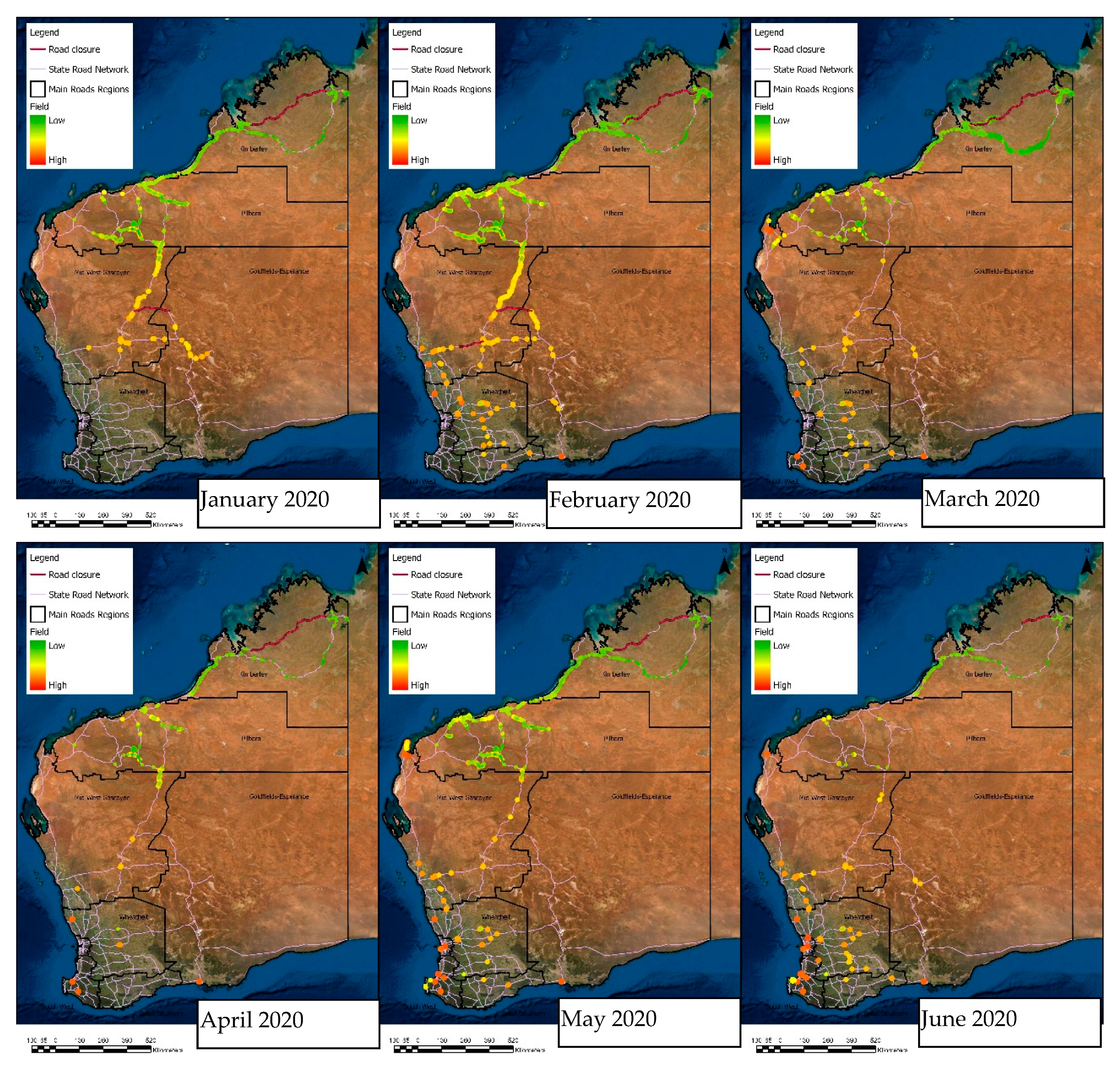
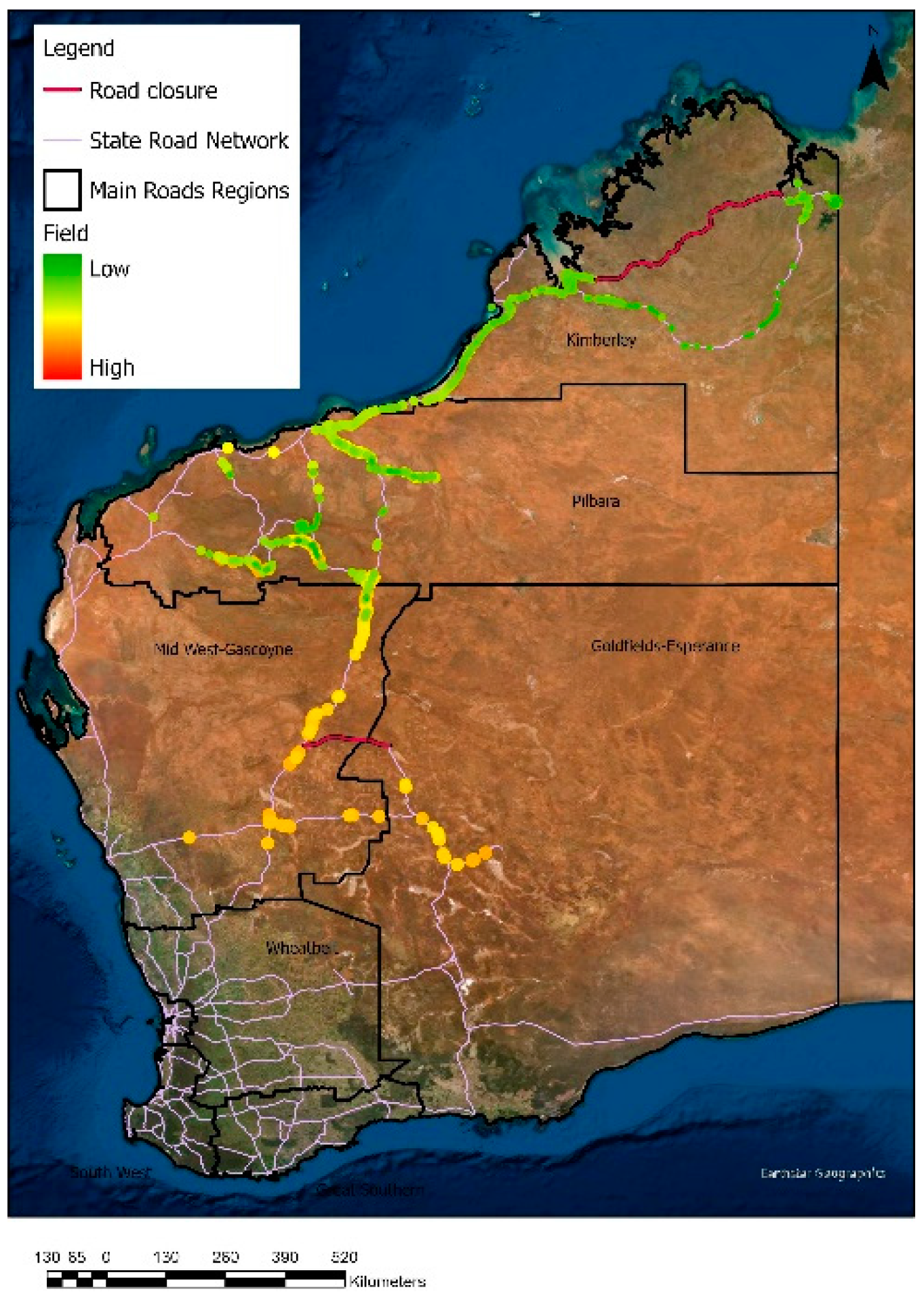
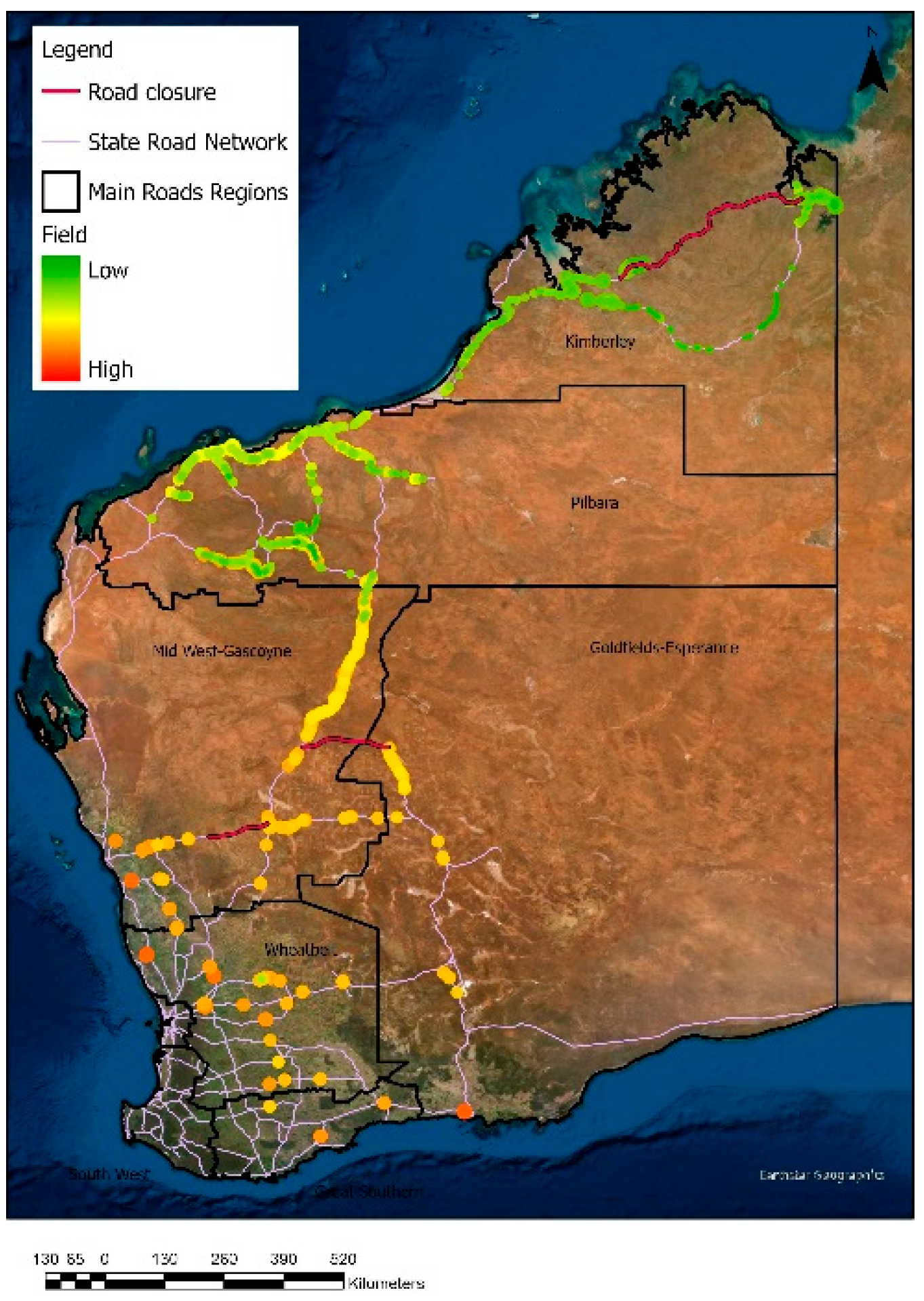
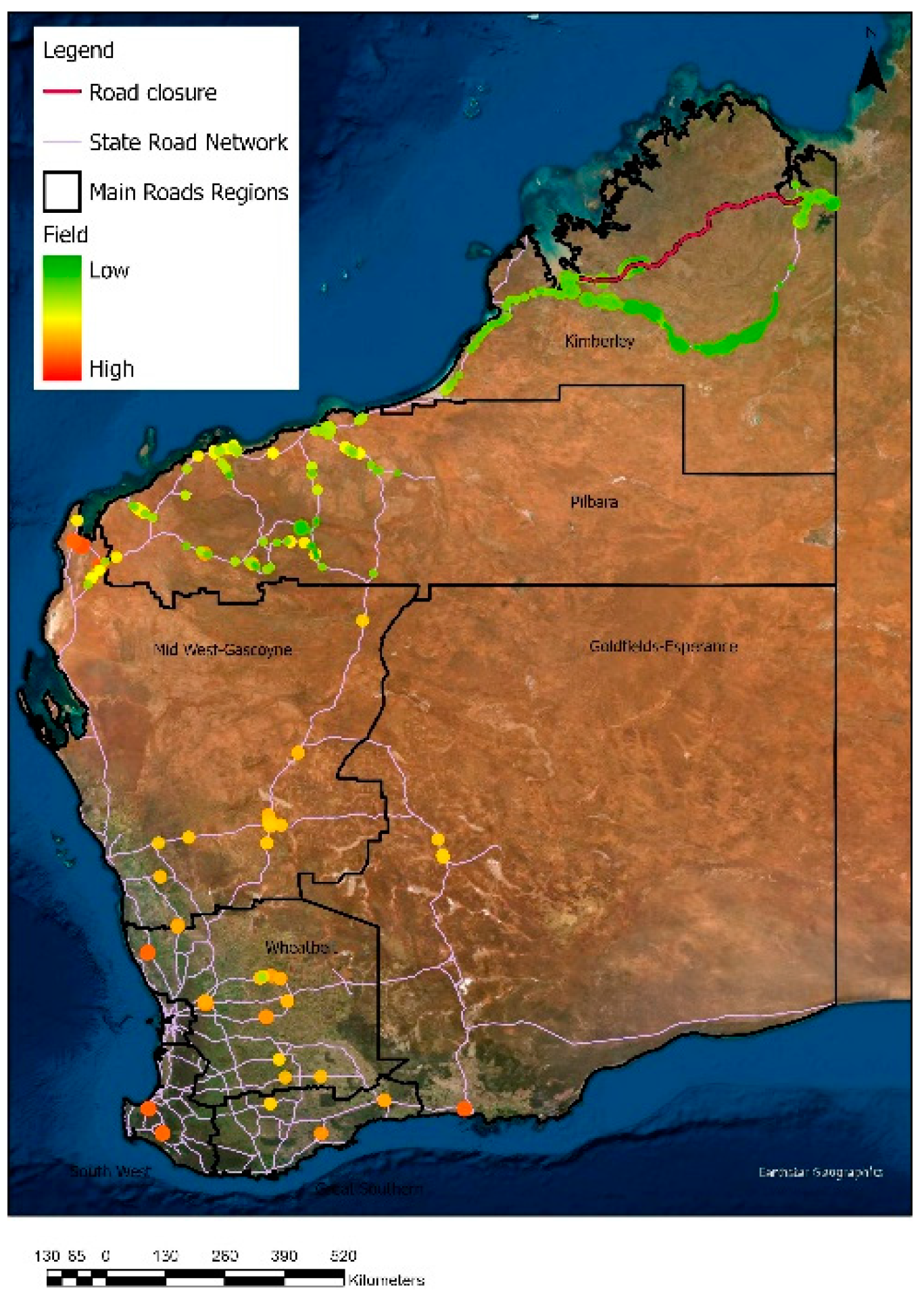

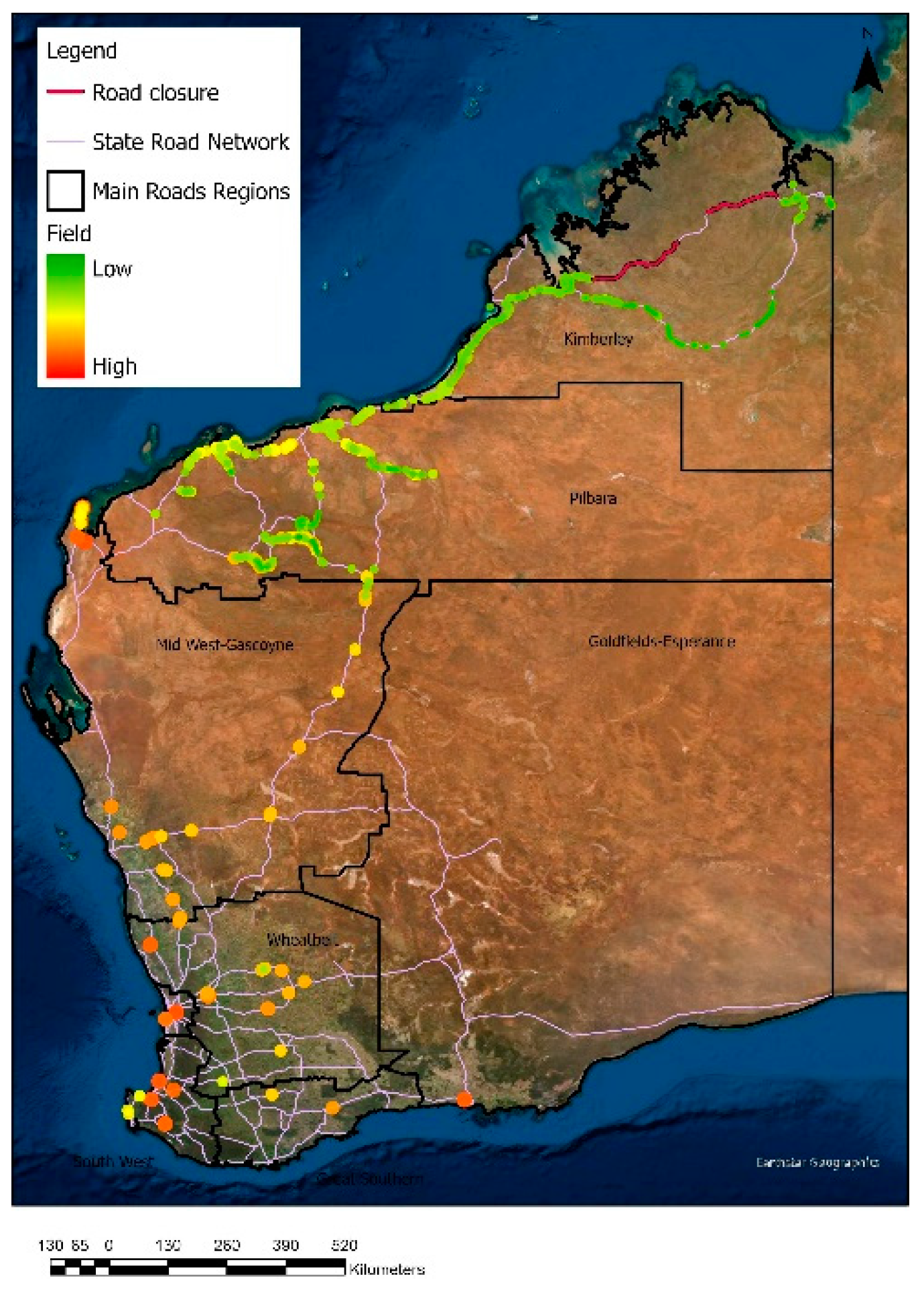
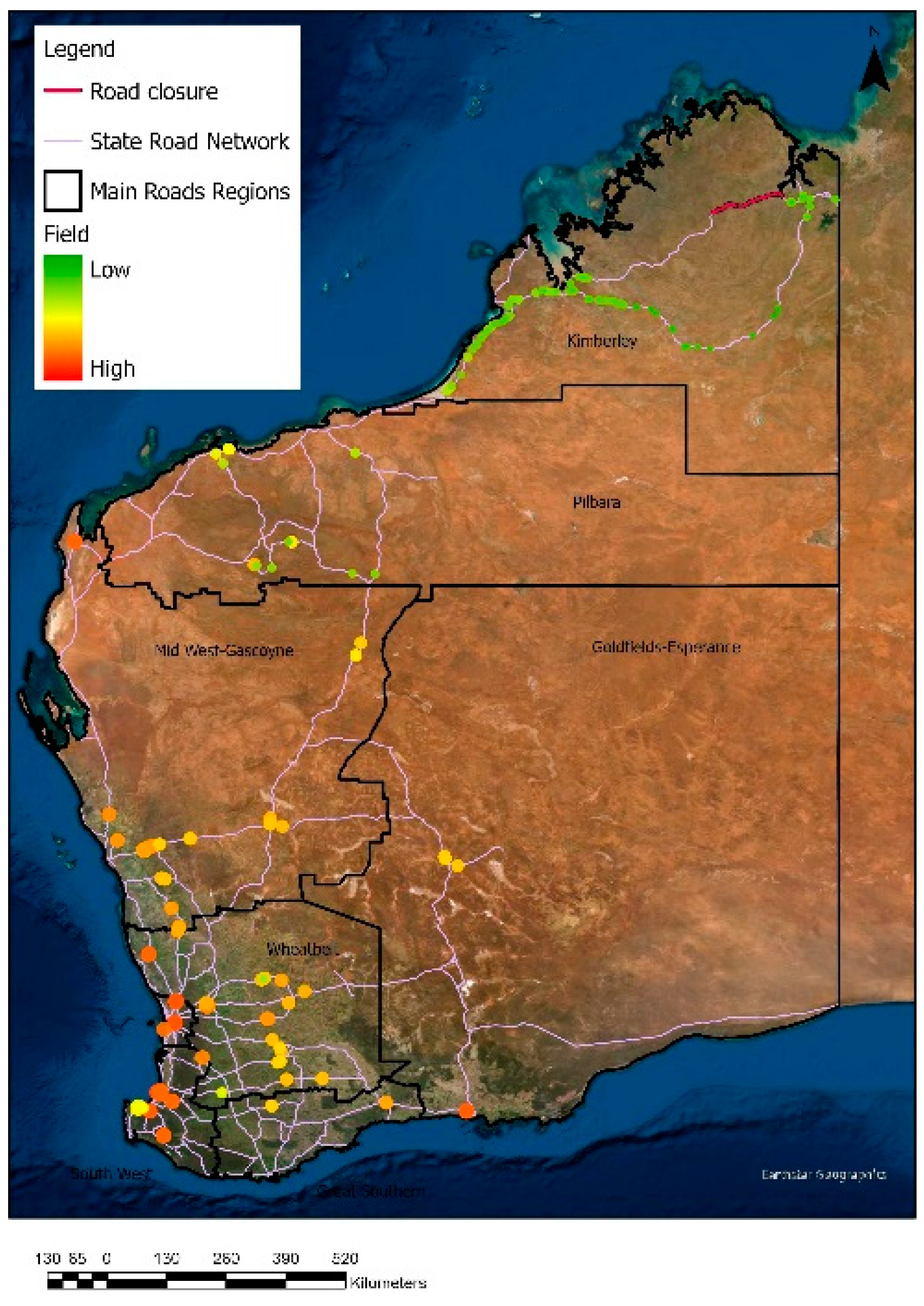
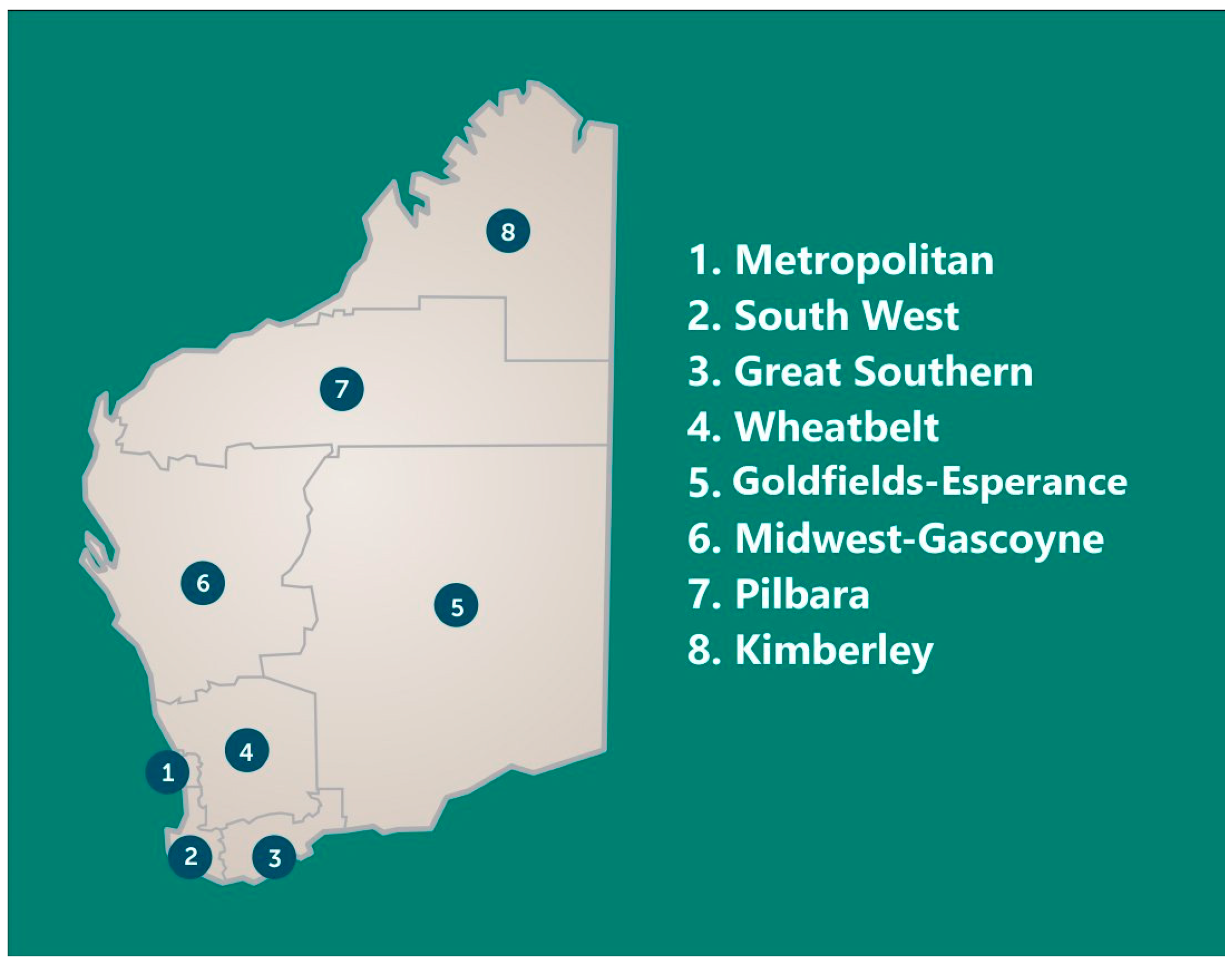
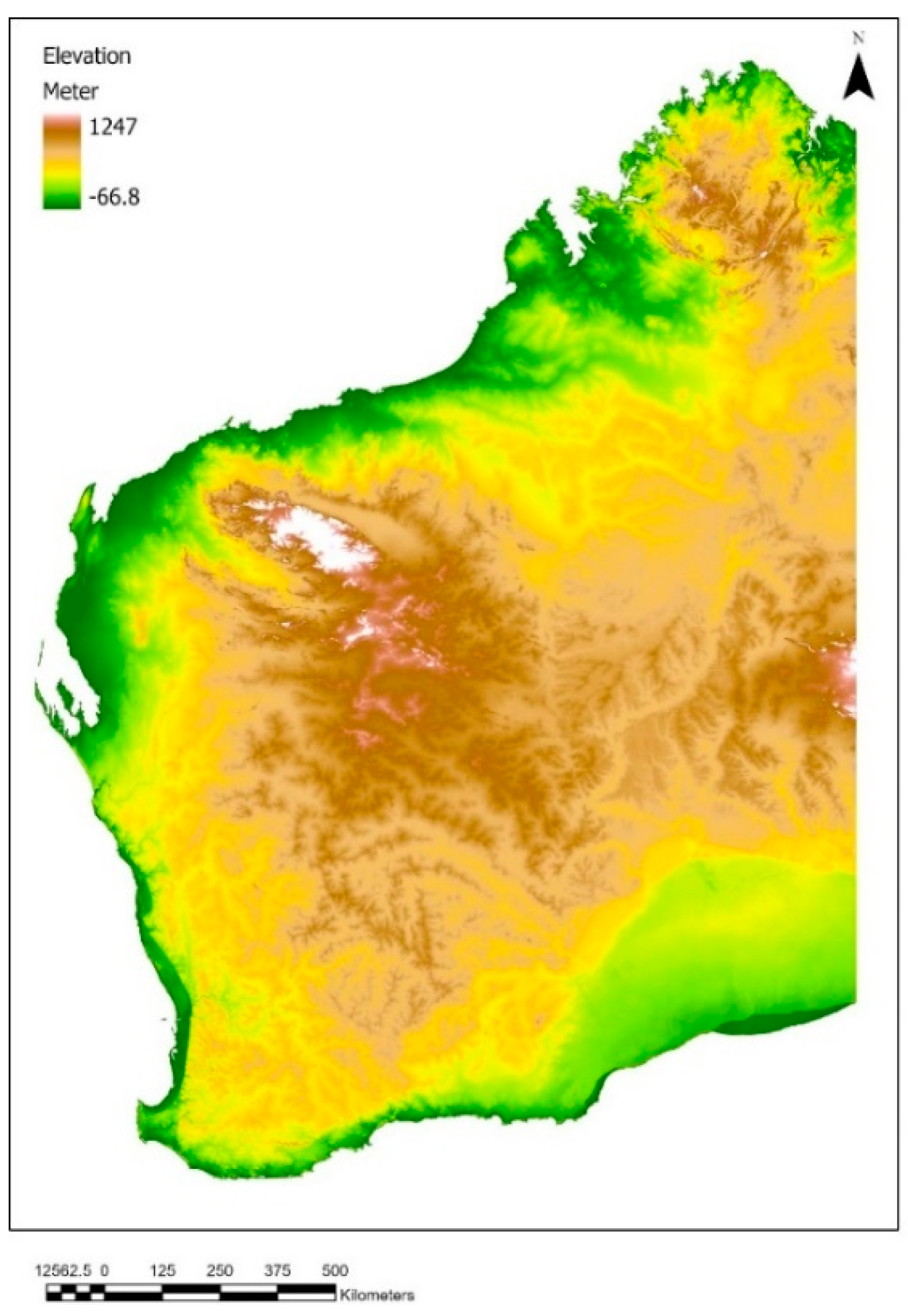
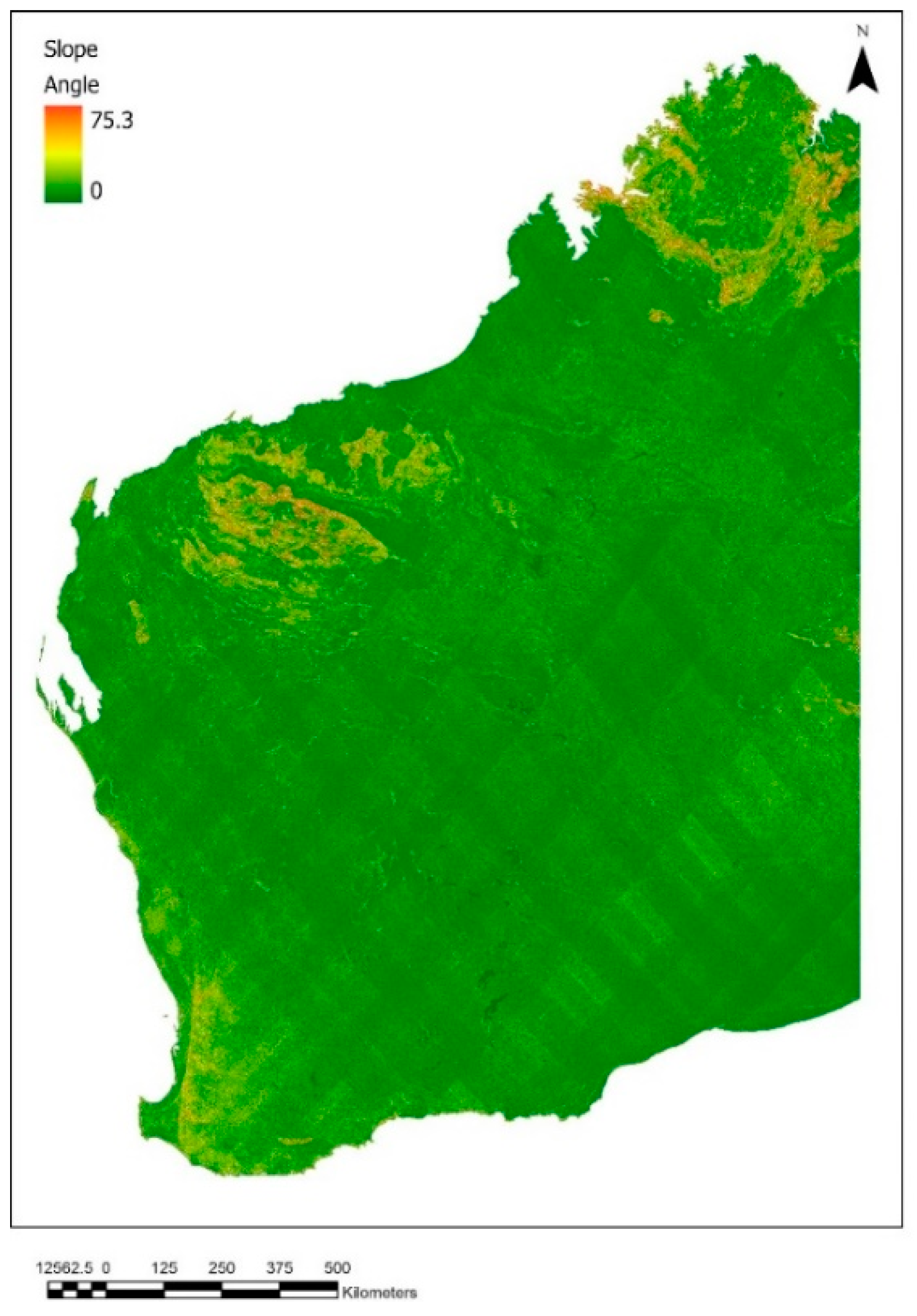
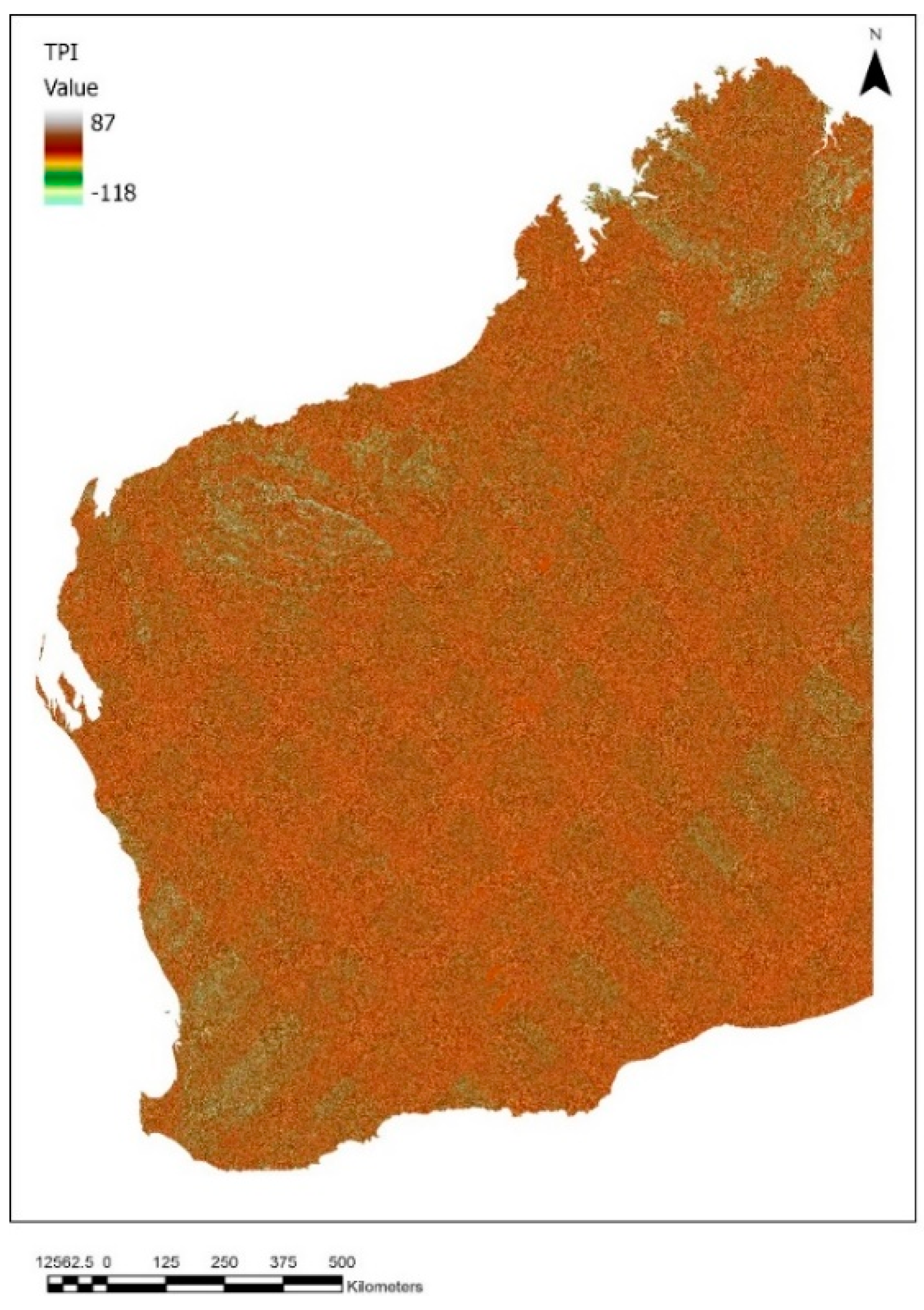
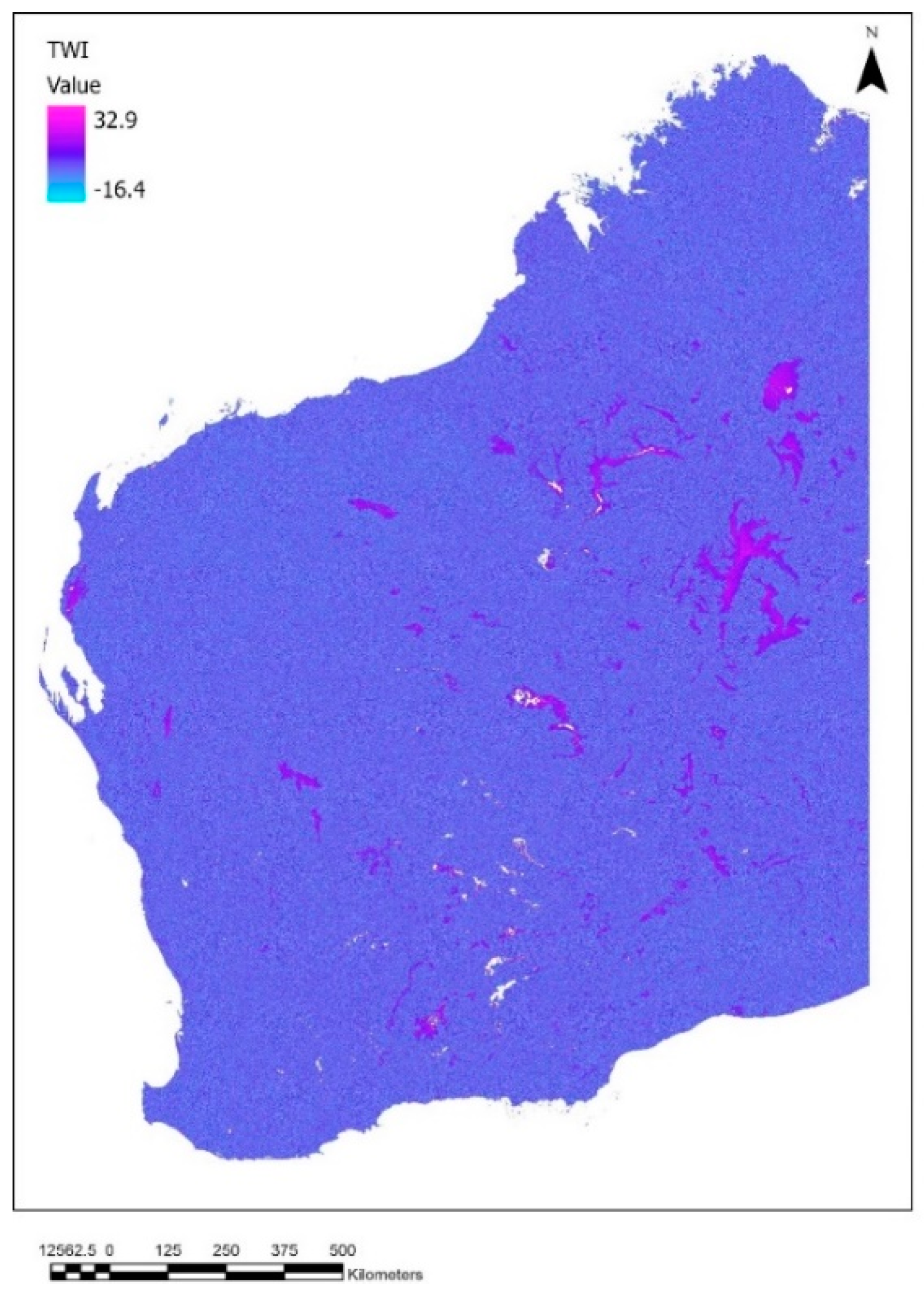
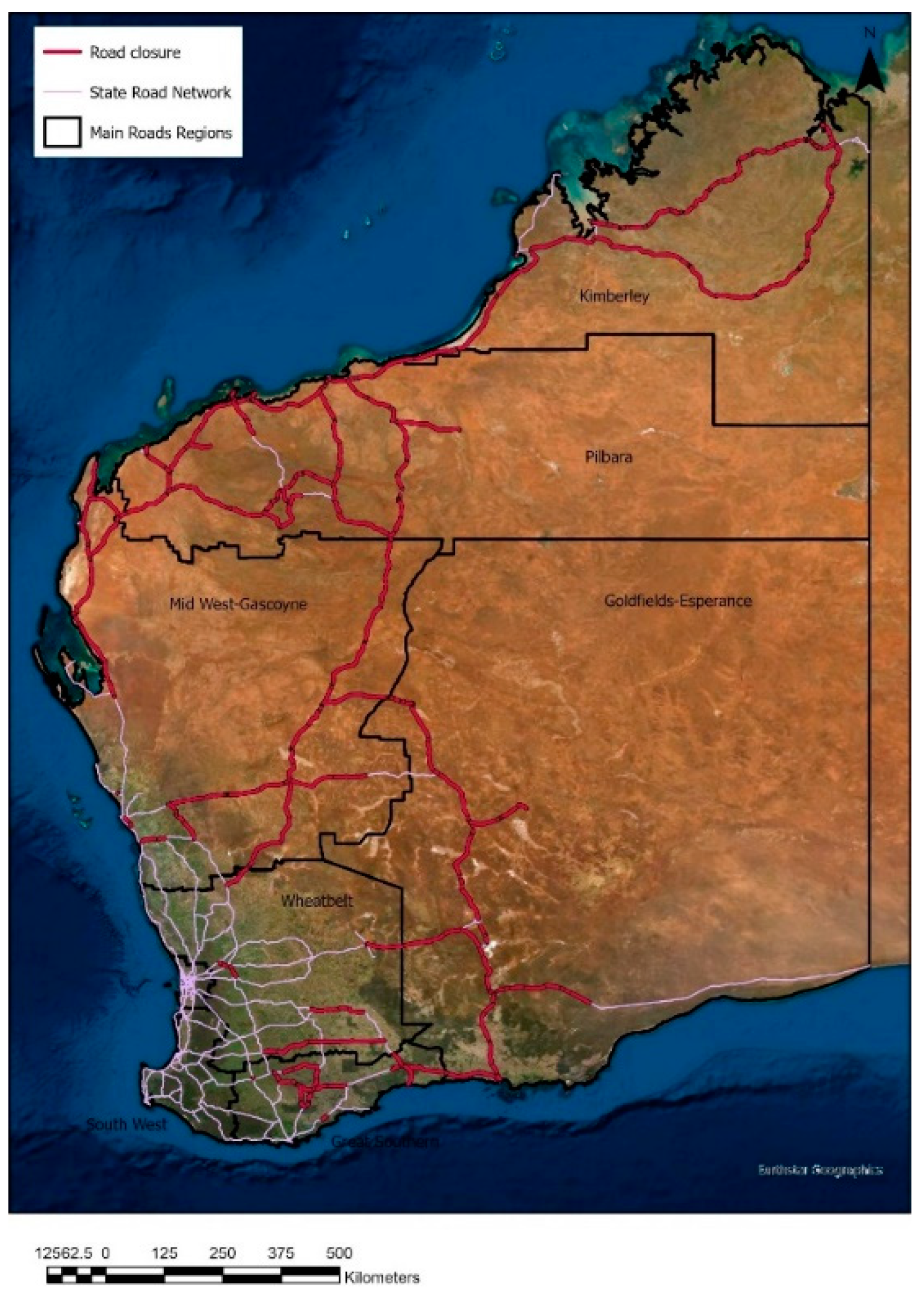
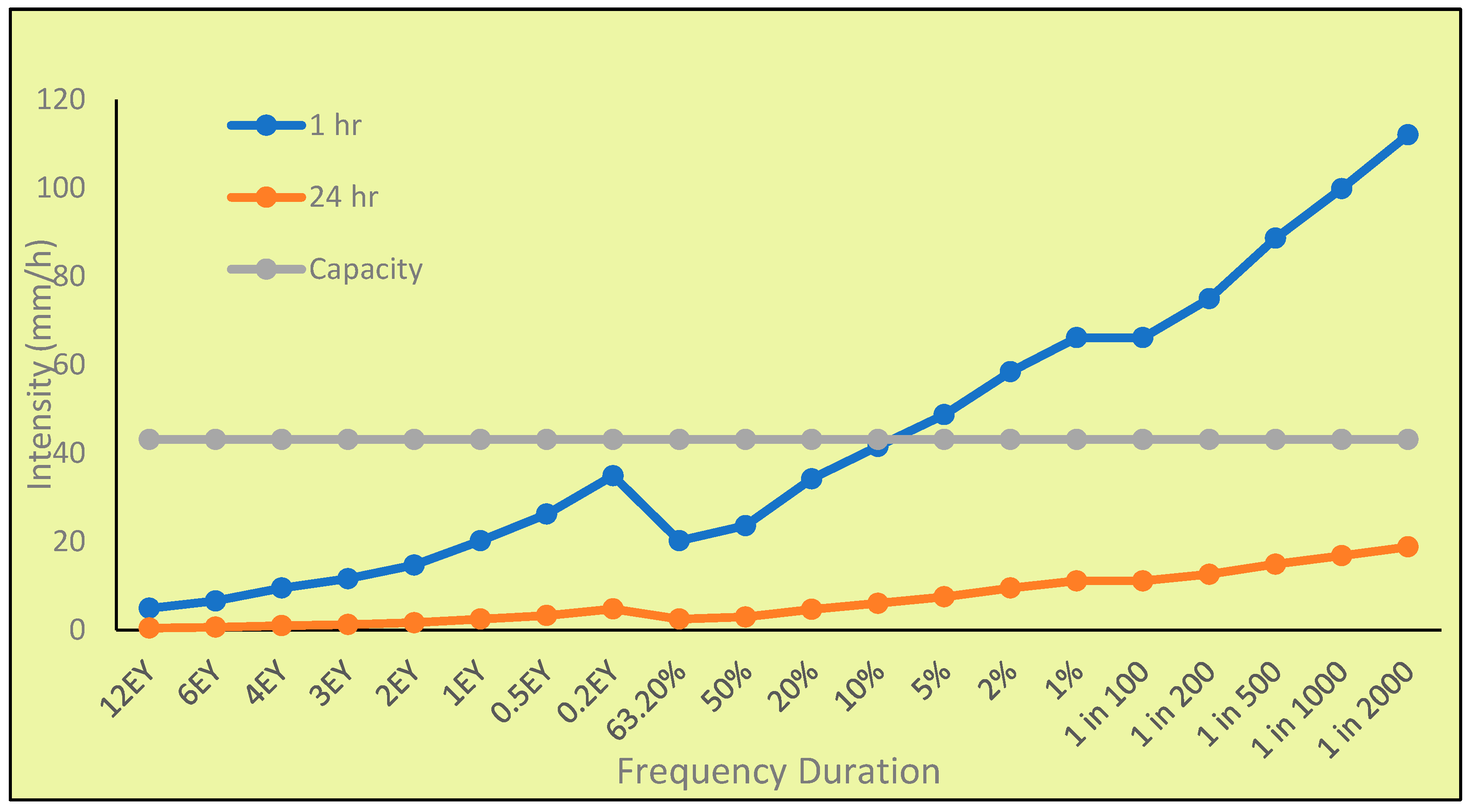

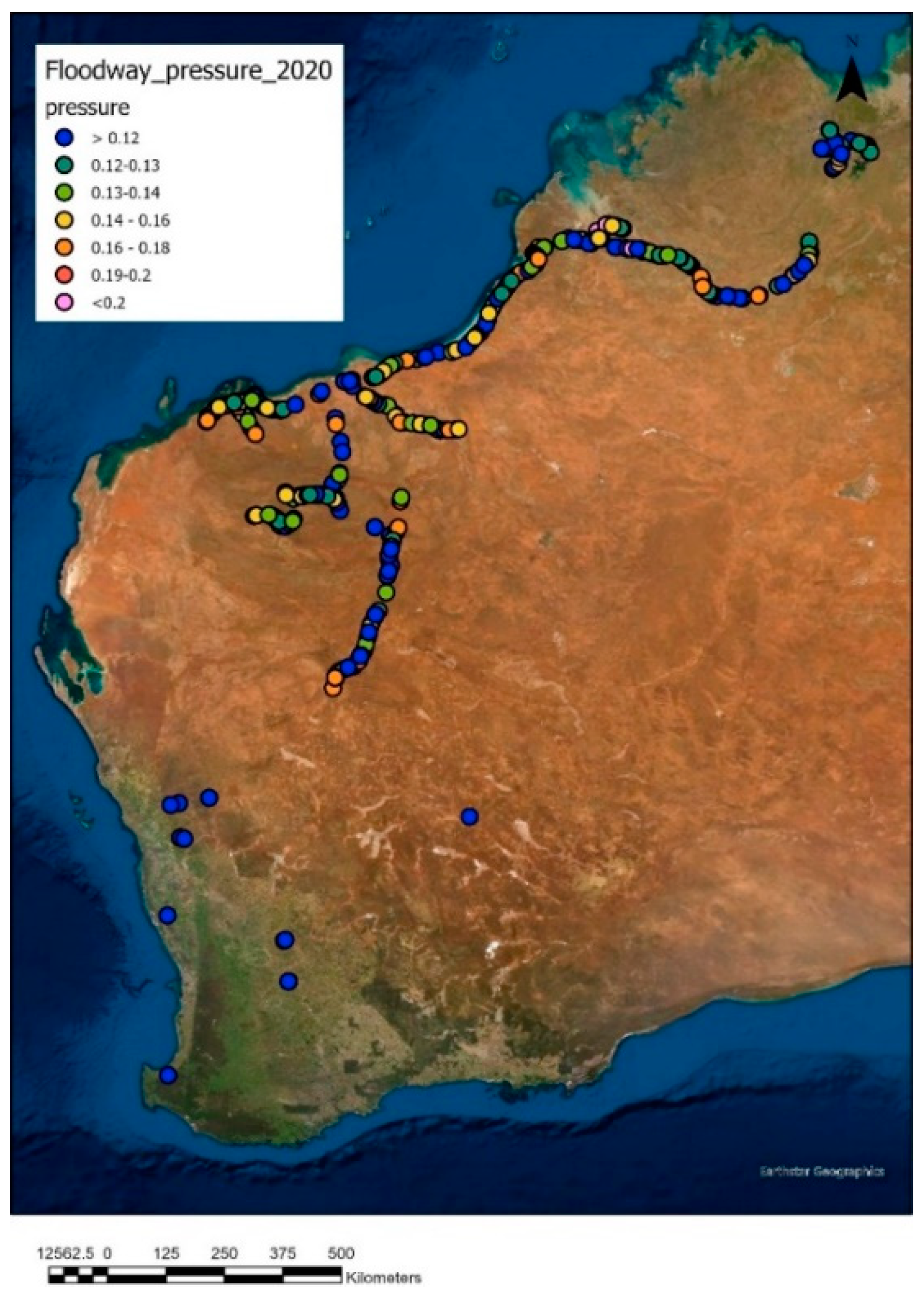
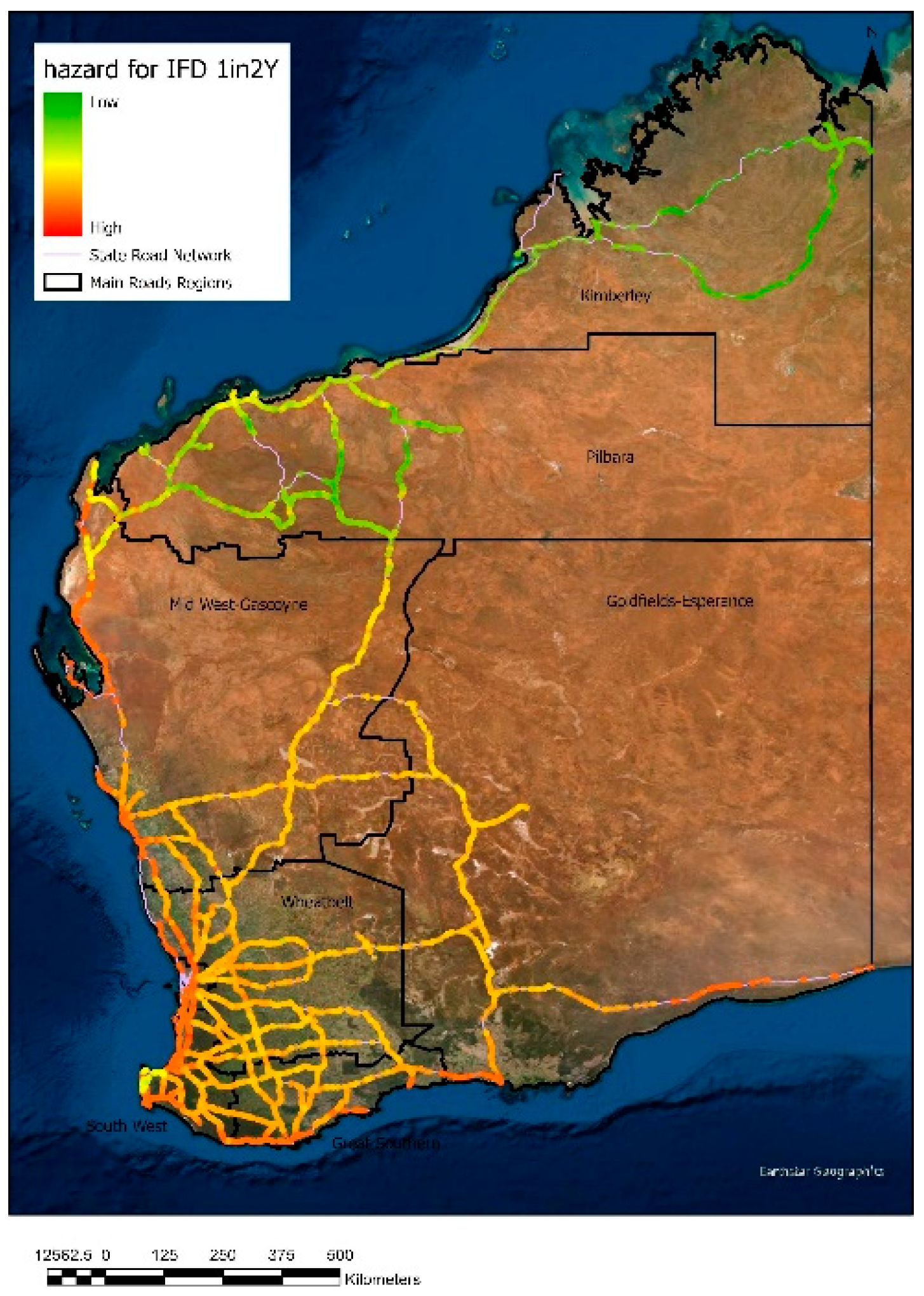
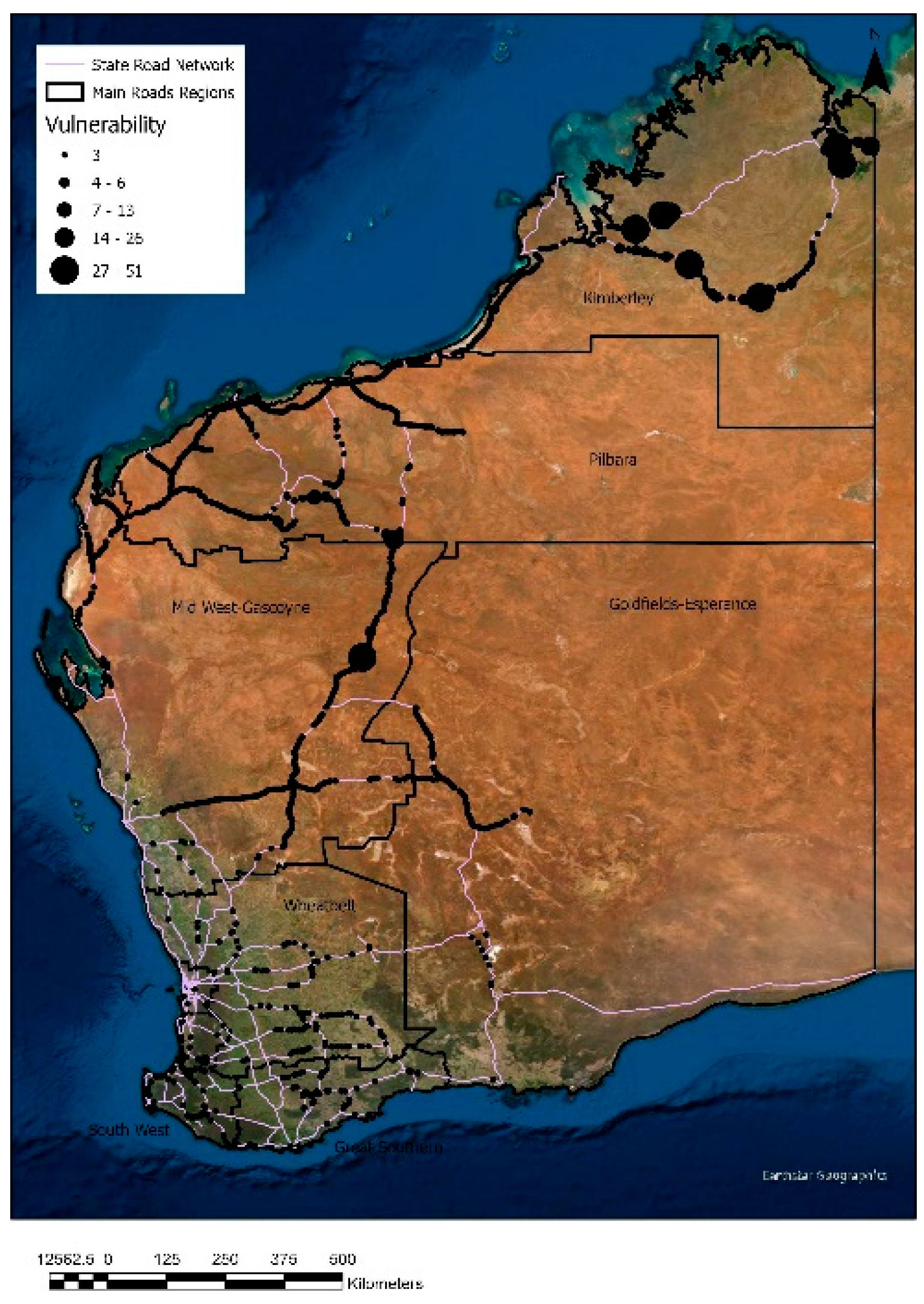
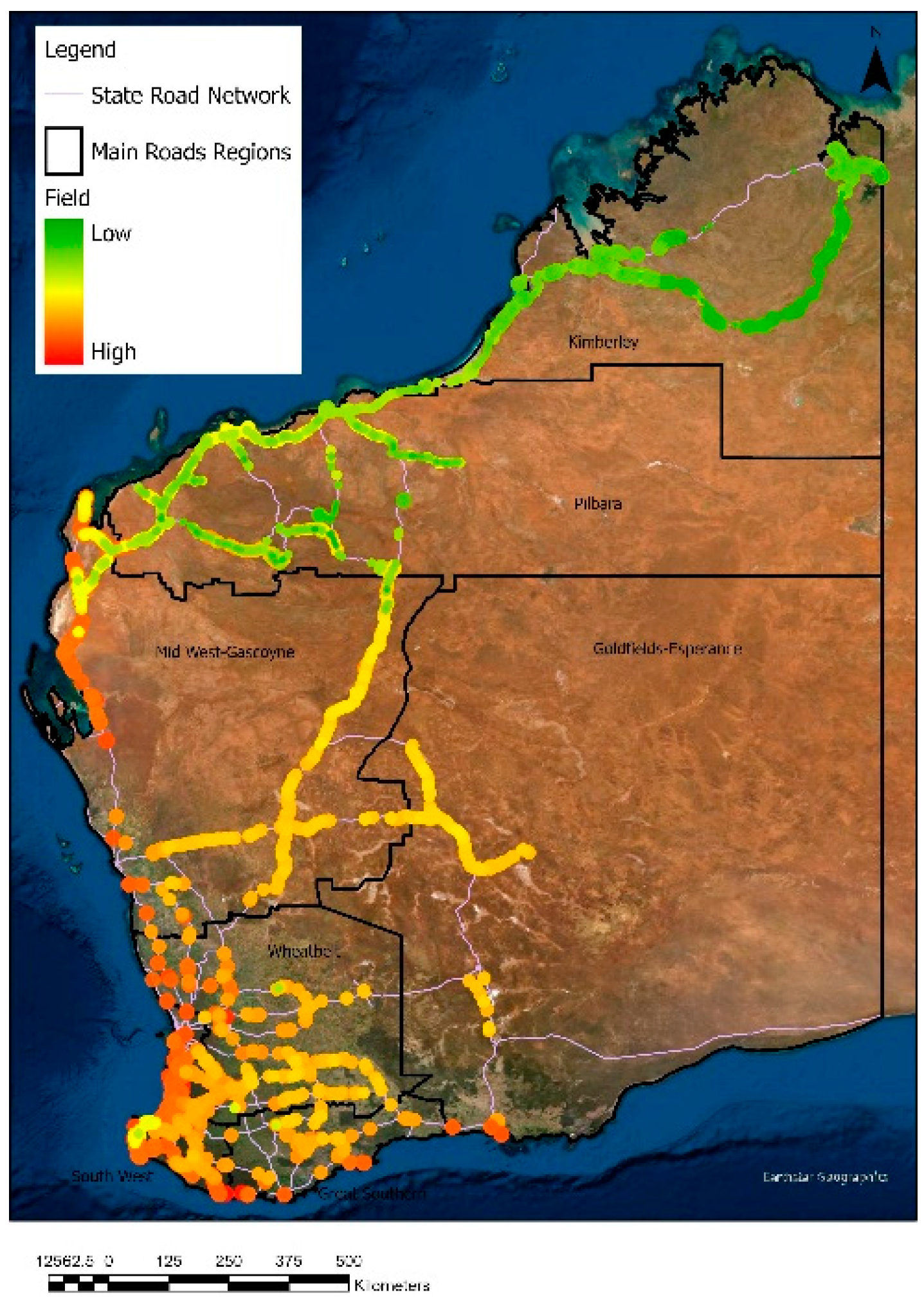
| Water Resources Models | WaterDyn | CABLE | AWRA-L Version 4.5 | AWRA-L Version 5 | AWRA-L Version 6 |
|---|---|---|---|---|---|
| Reference(s) | [21] | [22,23] | [17] | [18] | [20] |
| Organisation(s) | CSIRO, BoM, ABARES | CSIRO, BoM, universities | CSIRO, BoM | ||
| Purposes | Monitoring water balance | Land surface scheme | Water resources reporting, assessment, and monitoring | ||
| Key outputs | Parameter calibration and sensitivity analysis to 6 catchments in Murrumbidgee | Calibration to derived evapotranspiration (50 catchments within Australia) and flux tower data | Streamflow ~300 catchment | Streamflow ~300 catchment, satellite soil moisture, and evapotranspiration | Streamflow ~300 catchment, satellite soil moisture, evapotranspiration, and deep drainage |
| Periods for available simulation values | January 1900 to February 2014 (114 years) | January 1900 to December 2013 (114 years) | 1911–now (109+ years) | ||
| Reference | Water Resources Variable(s) | Region |
|---|---|---|
| [25] | River gauge height & weather forecasting | Brisbane, Australia |
| [30] | Rainfall & river flow | Europe (Italy, Austria) |
| [31] | Flood | Kelantan, Malaysia |
| [32] | Flood & asset management | NSW, Australia |
| [33] | Water storage, infiltration, & runoff | Korea |
| [34] | Flood | Queensland, Australia |
| [35] | Flood | Athens, Greece |
| [26] | Rainfall | Southeast Australia |
| [36] | Rainfall | Oklahoma, USA |
| [28] | Flood | Italy, Spain |
| [37] | Rainfall & runoff | China |
| [29] | Rainfall & flood forecasting | Korea |
| [38] | Streamflow & water level | Utah, USA |
| [39] | River inflow | Iran |
| [40] | Water levels | Sudan |
| [41] | Precipitation | Eastern Australia |
| [42] | Rainfall | India |
| [43] | Reservoir levels | Turkey |
| [44] | Streamflow | Canada |
| [14] | Streamflow | China |
| [45] | Floodplain forests | Melbourne, Australia |
| [46] | Streamflow | South-eastern Australia |
| [47] | Rainfall–runoff | Italy |
| [48] | Rainfall | Thailand |
| [49] | Rainfall | South-eastern Australia |
| [50] | Streamflow | Turkey |
| [51] | Flood forecasting | China |
| [52] | Streamflow | China |
| [53] | Rainfall–runoff | USA |
| [54] | Runoff forecast | China |
| [55] | Streamflow | Iran |
| Our Study | Rainfall, runoff, Drainage assets | Western Australia |
| Material | Mannings Value |
|---|---|
| Precast reinforced concrete | 0.013 |
| Prestressed concrete | 0.013 |
| Masonry | 0.013 |
| Timber | 0.017 |
| Steel | 0.01 |
| Plastic | 0.009 |
| Aluminium | 0.009 |
| In situ reinforced concrete | 0.013 |
| Mass concrete | 0.015 |
| Lithology | Land Use | TWI | Soil | TPI | Elevation | Slope | IFD | EE | RWI | RIW* Colum Totals | ||
|---|---|---|---|---|---|---|---|---|---|---|---|---|
| Lithology | ||||||||||||
| Land use | ||||||||||||
| TWI | ||||||||||||
| Soil | ||||||||||||
| TPI | ||||||||||||
| Elevation | ||||||||||||
| Slope | ||||||||||||
| IFD | ||||||||||||
| n | 1 | 2 | 3 | 4 | 5 | 6 | 7 | 8 |
|---|---|---|---|---|---|---|---|---|
| RI | 0 | 0 | 0.58 | 0.9 | 1.12 | 1.24 | 1.32 | 1.41 |
| Parameter | Source Data | Source Data Type | Process |
|---|---|---|---|
| Land use | Land use | Vector—Polygon feature |
|
| Soil flood hazard | Soil | Vector—Polygon Shapefile |
|
| Lithology | Lithology | Vector—Polygon feature |
|
| Elevation | DEM | Raster—Tiff |
|
| Slope | DEM | Raster—Tiff |
|
| Topographic wetness index | DEM | Raster—Tiff |
|
| Topographic position index | DEM | Raster—Tiff |
|
| Rainfall depth | Australia rainfall and runoff—Intensity frequency duration | Pont file—CSV |
|
| Asset pressure | Calculation in this project | Pont file—CSV |
|
| Lithology | Land Use | TWI | Soil | TPI | Elevation | Slope | IFD | Estimated Eigenvalue | Relative Importance Weight | RIW* Column Totals | |
|---|---|---|---|---|---|---|---|---|---|---|---|
| Lithology | 1.00 | 0.33 | 0.20 | 0.20 | 0.17 | 0.14 | 0.13 | 0.11 | 0.2141 | 0.02 | 0.73 |
| Land use | 3.00 | 1.00 | 0.33 | 0.20 | 0.20 | 0.17 | 0.14 | 0.13 | 0.3232 | 0.02 | 0.89 |
| TWI | 5.00 | 3.00 | 1.00 | 0.33 | 0.20 | 0.20 | 0.17 | 0.14 | 0.5125 | 0.04 | 1.10 |
| Soil | 5.00 | 5.00 | 3.00 | 1.00 | 0.33 | 0.20 | 0.20 | 0.17 | 0.7993 | 0.06 | 1.29 |
| TPI | 6.00 | 5.00 | 5.00 | 3.00 | 1.00 | 0.33 | 0.20 | 0.20 | 1.2510 | 0.10 | 1.45 |
| Elevation | 7.00 | 6.00 | 5.00 | 5.00 | 3.00 | 1.00 | 0.33 | 0.20 | 1.9511 | 0.15 | 1.52 |
| Slope | 8.00 | 7.00 | 6.00 | 5.00 | 5.00 | 3.00 | 1.00 | 0.33 | 3.0941 | 0.24 | 1.24 |
| IFD | 9.00 | 8.00 | 7.00 | 6.00 | 5.00 | 5.00 | 3.00 | 1.00 | 4.6715 | 0.36 | 0.83 |
| = 8.35; count = 8.00; consistency index = 0.05; relative consistency index = 1.41; consistency ratio = 0.03 | |||||||||||
| Parameter | Consistency Ratio | Classes | RWI |
|---|---|---|---|
| Land use | 0.06 | Conservation and natural environments | 0.03 |
| Production from relatively natural environments | 0.05 | ||
| Production from dryland agriculture and plantations | 0.09 | ||
| Production from irrigated agriculture and plantations | 0.16 | ||
| Intensive uses | 0.26 | ||
| water | 0.40 | ||
| Soil | 0.05 | 0–20 | 0.03 |
| 20–40 | 0.06 | ||
| 40–60 | 0.13 | ||
| 60–80 | 0.26 | ||
| 80–100 | 0.51 | ||
| Lithology | 0.02 | Sedimentary | 0.06 |
| Meta sedimentary | 0.10 | ||
| Metamorphic | 0.16 | ||
| Meta-Igneous | 0.26 | ||
| Igneous | 0.42 | ||
| TWI | 0.05 | 2.7 ≤ TWI ≤ 5.7 | 0.06 |
| 5.8 ≤ TWI ≤ 7.7 | 0.10 | ||
| 7.8 ≤ TWI ≤ 14.9 | 0.16 | ||
| 15 ≤ TWI ≤ 22.8 | 0.26 | ||
| 22.9 ≤ TWI ≤ 28.1 | 0.42 | ||
| Slope | 0.03 | 88–90 | 0.05 |
| 77–88 | 0.11 | ||
| 34–77 | 0.26 | ||
| 0–34 | 0.59 | ||
| 699–1440 | 0.03 | ||
| Depth IFD | 0.02 | 12–6 EY | 0.02 |
| 4–3 EY | 0.02 | ||
| 2–1 EY | 0.04 | ||
| 0.5–0.2 EY | 0.05 | ||
| 63–50% | 0.07 | ||
| 20–10% | 0.11 | ||
| 5–2% | 0.16 | ||
| 1 in 100–1 in 200 | 0.22 | ||
| 1 in 500–1 in 2000 | 0.31 | ||
| TPI | 0.04 | ≤−1 | 0.40 |
| −1 < TPI ≤ −0.5 | 0.25 | ||
| −0.5 < TPI < 0.5 | 0.16 | ||
| −0.5 < TPI < 0.5 | 0.09 | ||
| 0.5 < TPI ≤ 1 | 0.06 | ||
| >1 | 0.03 | ||
| Elevation | 0.04 | 476–699 | 0.06 |
| 288–476 | 0.13 | ||
| 124–288 | 0.26 | ||
| 0–124 | 0.51 |
| Parameter | Consistency Ratio | Classes | RWI |
|---|---|---|---|
| Pressure on culvert | 0.05 | 100–200 | 0.03 |
| 200–400 | 0.06 | ||
| 400–600 | 0.13 | ||
| 600–800 | 0.26 | ||
| 800–1000 | 0.51 | ||
| Pressure on floodway | 0.05 | 0–10 | 0.03 |
| 10–20 | 0.06 | ||
| 20–30 | 0.13 | ||
| 30–40 | 0.26 | ||
| 40–50 | 0.51 |
Disclaimer/Publisher’s Note: The statements, opinions and data contained in all publications are solely those of the individual author(s) and contributor(s) and not of MDPI and/or the editor(s). MDPI and/or the editor(s) disclaim responsibility for any injury to people or property resulting from any ideas, methods, instructions or products referred to in the content. |
© 2023 by the authors. Licensee MDPI, Basel, Switzerland. This article is an open access article distributed under the terms and conditions of the Creative Commons Attribution (CC BY) license (https://creativecommons.org/licenses/by/4.0/).
Share and Cite
Wongthongtham, P.; Abu-Salih, B.; Huang, J.; Patel, H.; Siripun, K. A Multi-Criteria Analysis Approach to Identify Flood Risk Asset Damage Hotspots in Western Australia. Sustainability 2023, 15, 5669. https://doi.org/10.3390/su15075669
Wongthongtham P, Abu-Salih B, Huang J, Patel H, Siripun K. A Multi-Criteria Analysis Approach to Identify Flood Risk Asset Damage Hotspots in Western Australia. Sustainability. 2023; 15(7):5669. https://doi.org/10.3390/su15075669
Chicago/Turabian StyleWongthongtham, Pornpit, Bilal Abu-Salih, Jeff Huang, Hemixa Patel, and Komsun Siripun. 2023. "A Multi-Criteria Analysis Approach to Identify Flood Risk Asset Damage Hotspots in Western Australia" Sustainability 15, no. 7: 5669. https://doi.org/10.3390/su15075669
APA StyleWongthongtham, P., Abu-Salih, B., Huang, J., Patel, H., & Siripun, K. (2023). A Multi-Criteria Analysis Approach to Identify Flood Risk Asset Damage Hotspots in Western Australia. Sustainability, 15(7), 5669. https://doi.org/10.3390/su15075669













